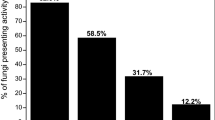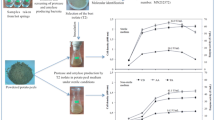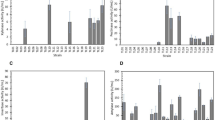Abstract
The present study aimed to investigate and compare the enzymatic production of endophytic bacteria isolated from healthy and brittle leaf disease affected date palm leaves (pectinase, cellulase, lipase, and amylase). The findings revealed that the enzymatic products from the bacterial isolates of healthy date palm leaves were primarily 33% amylolytic enzyme, 33 % cellulase, 25 % pectinase, and 25 % lipase. The isolates from brittle leaf disease date palm leaves, on the other hand, were noted to produce 16 % amylolytic enzyme, 20 % cellulose, 50 % pectinase, and 50 % lipase. The effects of temperature and pH on amylase, pectinase, and cellulose activities were investigated. The Bacillus subtilis JN934392 strain isolated from healthy date palm leaves produced higher levels of amylase activity at pH 7. A Box Behnken Design (BBD) was employed to optimize amylase extraction. Maximal activity was observed at pH and temperature ranges of pH 6–6.5 and 37–39 °C, respectively. Under those conditions, amylase activity was noted to be attained 9.37 U/ml. The results showed that the enzyme was able to maintain more than 50 % of its activity over a temperature range of 50–80 °C, with an optimum at 70 °C. This bacterial amylase showed high activity compared to other bacteria, which provides support for its promising candidacy for future industrial application.





Similar content being viewed by others
Abbreviations
- B.m:
-
Bacillus megaterium
- B.sub:
-
Bacillus subtilis JN 934389
- B.s:
-
Bacillus sonoensis
- B.e:
-
Bacillus endophyticus
- B.saf:
-
Bacillus safensis
- A.a:
-
Arthrobacter agilis JN934384
- M.b:
-
Microbacterium barkeri JN9343388
- M.a:
-
Microbacterium aerolatum JN934392
- P.s:
-
Pseudomonas sutzeri JN934394
- S.n:
-
Staphylococcus napalensis
- S.s:
-
Staphylococcus saccharolyticus
- K.r :
-
Kocuria rosea
- P.sp:
-
Pantoea sp.
- E.h:
-
Enterobacter hormaechei
- M.o:
-
Flavobacteriacea: Myroides odoratimimus
References
Eisenmenger, M. J., & Reyes, J. I. (2009). High pressure enhancement of enzymes: a review. Enzymology Microbiological Technology, 45, 331–347.
Jayani, R. S., Saxena, S., & Gupta, R. (2005). Microbial pectinolytic enzymes: a review. Process Biochemistry, 40, 2931–2944.
Lee, S. M., & Koo, Y. M. (2001). Microbial cellulases and its applications: a review. Applied Microbiology and Biotechnology, 11, 229–233.
Yi, Y. C., Sandra, J. C., John, A. B., & Shu, T. C. (1999). Production and distribution of endoglucanase, cellobiohydrolase, and b-glucosidase components of the cellulolytic system of volvariella volvacea, the edible straw mushroom. Applied and Environmental Microbiology, 65, 553–559.
Bhat, M. K. (2000). Cellulases and related enzymes in biotechnology. Biotechnology Advances, 18, 355–383.
Hamilton, M., Catherine, K., & William Fogarty, M. (1999). Purification and properties of the raw starchdegrading a- amylase of Bacillus sp. IMD 434. Proceedings Biochemistry, 35, 27–31.
Pandey, A., Nigam, P., Soccol, C. R., Soccol, V. T., Singh, D., & Mohan, R. (2000). Advances in microbial amylases. Applied Biochemistry, 3, 135–152.
Bornschener, U. T., Bessler, C., Srinivas, R., & Krishna, S. H. (2002). Optimizing lipases and related enzymes for efficient application. Trends in Biotechnology, 20, 433–437.
Kobayashi, T., Hatada, Y., Higaki, N., Tusterio, D. D., Ozawaa, T., Koike, K. et al. (1999). Enzymatic properties and deduced amino acid sequence of a high-alkaline pectate lyase from an alkaliphilic Bacillus isolate. Bichem Biophys Acta. 145–154.
Bragger, J. M., Daniel, R. M., & Morgan, H. W. (1989). Very stable enzymes from extremely thermophilic archaebacteria and eubacteria. Applied Microbiology and Biotechnology, 31, 556–561.
Mandels, M., & Weber, J. (1969). Production of cellulases. Advanced Chemical, 95, 391–414.
Miller, G. L. (1959). Use of dinitrosalicylic acid reagent for determination of reducing sugar. Analytical Chemistry, 31, 426–428.
Mathieu, D., Nony, J., & Phan-Than-Luu, R. (2000). NEMROD-W software. Marseille: LPRAI.
McInroy, J. A., & Kloepper, J. W. (1995). Survey of indigenous bacterial endophytes from cotton and sweet corn. Plant and Soil, 173, 337–342.
Aysha, J., Ivonilde, C., Edweis, C. B., & José, D. G. (2006). Enzymatic activity of endophytic bacterial isolates of jacaranda decurrens cham. (Carobinha-do-campo). Brazilian Archives of Biology and Technology, 49, 353–359.
Vatanparast, M., Hosseinivaveh, V., Ghadamyari, M., & Sajjadian, S. M. (2012). Pectinase and cellulase activity in the digestive system of the elm leaf beetle, Xanthogaleruca luteola Muller (Coleoptera: Chrysomelidae). Journal of Asia-Pacific Entomology, 15, 555–561.
Yanzhen, M., Yuru, C., Ruying, Z., & Yang, L. (2013). Cloning, purification and biochemical properties of a thermostable pectinase from Bacillus halodurans M29. Journal of Molecular Catalysis B: Enzymatic, 94, 77–81.
Nath, M., & Hindumathy, C. K. (2012). Isolation, Optimization and Purification of Lipase from Myroides odoratimimus. International Journal Latest Research in Science and Technology, 1, 239–246.
Neelamegam, A., Mayavan, V. R., Sivara, M. E., & Thangavel, B. (2013). Thermostable, haloalkine cellulase from Bacillus halodurans CAS 1 by conversion of lignocellulosic wastes. Carbohydrate Polymers, 94, 409–415.
Mohamed, S. A., Drees, E. A., El-Badry, M. O., & Fahmy, A. S. (2010). Biochemical properties of alpha-amylase from peel of Citrus sinensis cv. Abosora. Applied Biochemistry and Biotechnology, 160, 2054–2065.
Hashemi, M., Seyyed, M. M., Seyed, H. R., & Seyed, A. S. (2013). Comparison of submerged and solid state fermentation systems effects on the catalytic activity of Bacillus sp. KR-8104 a-amylase at different pH and temperatures. Industrial Crops and Products, 43, 661–667.
Haki, G. D., Anceno, A. J., & Rakshit, S. K. (2008). Production, purification and characterization of Bacillus sp. GRE7 xylanase and its application in eucalyptus Kraft pulp biobleaching. World Journal of Microbiology and Biotechnology, 24, 2517–2524.
Khannous, L., Jrad, M., et al. (2014). Isolation of a novel amylase and lipase-producingPseudomonas luteola strain: study of amylase production conditions. Lipids in Health and Disease, 13.
Petrova, P., Emanuilova, M., & Petrov, K. (2010). Amylolytic Lactobacillus Strains from Bulgarian fermented beverage Boza. Zeitschrift für Naturforschung, 65, 218–224.
Author information
Authors and Affiliations
Corresponding author
Rights and permissions
About this article
Cite this article
Mouna, J., Imen, F., Choba Ines, B. et al. Enzymatic Activities in Different Strains Isolated from Healthy and Brittle Leaf Disease Affected Date Palm Leaves: Study of Amylase Production Conditions. Appl Biochem Biotechnol 175, 2075–2086 (2015). https://doi.org/10.1007/s12010-014-1409-x
Received:
Accepted:
Published:
Issue Date:
DOI: https://doi.org/10.1007/s12010-014-1409-x




